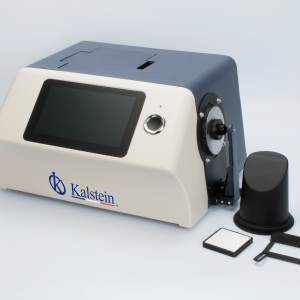A spectrophotometer is a laboratory equipment used to measure the absorbance of a sample, as a function of the wavelength of an electromagnetic radiation, and thus know the concentration of substances in a solution. In general, this equipment consists of 4 main parts: a source, a monochromator, a beam splitter, a sample area and a detector. It also has optical elements such as lenses or mirrors, which transmit light throughout the entire equipment.
This instrument has the property of projecting a monochromatic beam of light through a sample and measuring the amount of light that is absorbed by that sample. This can be used to obtain information on the nature of the sample and indirectly indicate how much of the substance we are interested in is present in the sample. Thus spectrophotometers are used in measuring the spectrum at all wavelengths for visible light and not only pre-specified wavelengths.
Technology and optical configuration of spectrophotometers
Single Beam Spectrophotometer: In this type of spectrophotometer, the target and sample are measured consecutively, with an interval ranging from several seconds for single wavelength readings to several minutes for full spectrum readings. Deviations from the lamp can result in significant errors during long intervals of time.
Double beam spectrophotometer: This spectrophotometer compensates for changes in lamp intensity between target and sample measurements. In this configuration, the light source emits a single beam of light that is divided by a cutter, creating two beams of equal energy and identical optical path. One beam passes through the reference while the other one passes through the sample. Compared to single beam design, double beam spectrophotometers have more optical components, which translates into higher performance and sensitivity.
Split beam spectrophotometer: In its structure instead of a cutter, they use a beam splitter to send light through the target and sample simultaneously, by two separate but identical detectors. This design allows both the target and the sample to be measured simultaneously. Split beam design is mechanically simpler than double beam design, and requires fewer optical components.
How does a spectrophotometer work?
The spectrophotometer is a laboratory equipment that projects a monochromatic sunline, i.e., a single color and passes through a sample or substance to know its level of absorption. There are several types of spectrophotometers, and they are classified according to the type of sample analyzed; there are atomic absorption and molecular absorption (UV-VIS spectrophotometer). A UV-VIS spectrophotometer is a device whose operation is based on the process of absorption of ultraviolet-visible radiation (wavelength radiation between 200 and 780 nm) by a molecule. The absorption of this radiation causes the promotion of an electron to an excited state.
Spectrophotometers work by isolating light at specific wavelengths from white light. A spectrophotometer breaks the light in its spectrum, using a color grid or similar system. Then a set of sensors reads each section of the spectrum, producing the spectral information. This equipment is used to measure, as a function of wavelength, the relationship between values of the same photometric magnitude relative to two radiation beams and the chemical concentration or reactions measured in a sample. Used in laboratories for the quantification of substances and microorganisms.
What does Kalstein offer you?
Kalstein is a manufacturer of medical and laboratory equipment of the highest quality and the best technology at the best PRICES in the market, so you can make your PURCHASE confidently with us, knowing that you have the service and advice of a company specialized in the field and committed to provide you with safe, economical and effective options to perform your functions in the right way.
This time we present our double beam UV/Vis spectrophotometer – YR01862. This innovative equipment with cutting edge technology has the following features:
- Dual optical path, dual beam optical system, dual detector, with high imported grid performance, lower parasitic light, higher stability, reliability, more accurate analysis
- Equipped with 10” touch screen, built-in 32G memory, Bluetooth network support
- Dynamic functions, DNA/protein testing, multiple wavelength testing and data printing
- Adopt the suspension design of the optical system, all the optical path is independently fixed on the 16mm thick aluminum deformation free base
- Vibration from the outside has no impact on the optical system, greatly improving the stability and reliability of the instrument
- W ITH powerful storage function, the instrument can be directly connected to the printer for A4 format data and graphic printing
- ITH automatic start check and positioning system functions, to repair the deviation caused by a long-term application. HERE
For more information we invite you to take a look HERE


